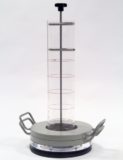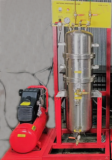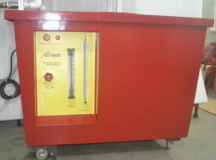Fundamentals of Sedimentation Model FM 115
Home » Products » Fundamentals of Sedimentation Model FM 115
Fundamentals of Sedimentation Model FM 115
Using Sci-tech Fundamentals of Sedimentation Model FM 115, the sedimentation processes in different suspensions can be investigated and compared.
| Size: | 60cm x 20cm x 95cm (LxWxH) |
| Weight: | 25 kg |
Item Description
Features
Visualization of cavitation effects in a transparent pump
Continuously adjustable pump speed
Closed water circuit
Sedimentation is often used to clarify suspensions. In the process, the solid particles move downwards in a liquid owing to their density.
Using Sci-tech Fundamentals of Sedimentation Model FM 115, the sedimentation processes in different suspensions can be investigated and compared. Five transparent cylindrical tanks are provided for the purpose. The suspensions are prepared in measuring cups, poured into the removable tanks, and mixed by shaking. The tanks are then mounted vertically on the experimental unit. To aid observation of the sedimentation process, the tanks are backlit.
Technical Specifications
- Experiments in the fundamentals of sedimentation
- 5 transparent tanks with scale for comparison of the settling velocities of solids in various suspensions
- Tanks removable for filling, mixing and cleaning
- Tanks backlit by fluorescent tubes to aid observation
- 3 measuring cups for preparation of suspensions
- Pycnometer to determine the density of the liquids and solids
- Stopwatch to record the sedimentation time
- Recommended accessories: balance, coagulant
Technical Specifications
Tanks
- length: 1000mm
- inside diameter: 42mm
- scale division: 1mm
- material: PMMA
Fluorescent tubes
- power: 6x 18W
Measuring cups
- capacity: 2000ml
- scale division: 50ml
Stopwatch
- resolution: 1/100sec
Experiments
- Determination and comparison of the settling velocities of solids in suspensions dependent on the solid density and concentration and the liquid density and viscosity
- Influence of coagulants on the settling velocity
Model Number
FM 115
See also different:

Sci-tech Drain Permeameter Model FM-36 is suited for use both as a teaching and demonstration tool and for laboratory testing and research.

Sci-tech Nutsche Pressure Filters Apparatus Model FM 117 are used for discontinuous cake filtration of suspensions with high solid concentrations. The suspension production unit produces a suspension of diatomite and water and delivers it from [...]

Sci-tech Base Digital Hydraulic Bench Module for Experiments in Fluid Mechanics FM 100F is of volumetric type and has been designed to provide continuous and controlled supply of water to conduct various experiments using auxiliary modules in [...]

